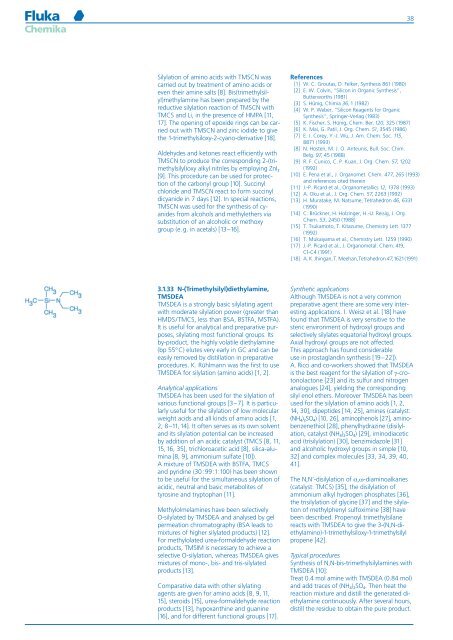Silylation Overview - Sigma-Aldrich
Silylation Overview - Sigma-Aldrich
Silylation Overview - Sigma-Aldrich
Create successful ePaper yourself
Turn your PDF publications into a flip-book with our unique Google optimized e-Paper software.
Fluka<br />
Chemika<br />
<strong>Silylation</strong> of amino acids with TMSCN was<br />
carried out by treatment of amino acids or<br />
even their amine salts [8]. Bis(trimethylsilyl)methylamine<br />
has been prepared by the<br />
reductive silylation reaction of TMSCN with<br />
TMCS and Li, in the presence of HMPA [11,<br />
17]. The opening of epoxide rings can be carried<br />
out with TMSCN and zinc iodide to give<br />
the 1-trimethylsiloxy-2-cyano-derivative [18].<br />
Aldehydes and ketones react efficiently with<br />
TMSCN to produce the corresponding 2-(trimethylsilyl)oxy<br />
alkyl nitriles by employing ZnI 2<br />
[9]. This procedure can be used for protection<br />
of the carbonyl group [10]. Succinyl<br />
chloride and TMSCN react to form succinyl<br />
dicyanide in 7 days [12]. In special reactions,<br />
TMSCN was used for the synthesis of cyanides<br />
from alcohols and methylethers via<br />
substitution of an alcoholic or methoxy<br />
group (e.g. in acetals) [13–16].<br />
3.1.33 N-(Trimethylsilyl)diethylamine,<br />
TMSDEA<br />
TMSDEA is a strongly basic silylating agent<br />
with moderate silylation power (greater than<br />
HMDS/TMCS, less than BSA, BSTFA, MSTFA).<br />
It is useful for analytical and preparative purposes,<br />
silylating most functional groups. Its<br />
by-product, the highly volatile diethylamine<br />
(bp 55°C) elutes very early in GC and can be<br />
easily removed by distillation in preparative<br />
procedures. K. Rühlmann was the first to use<br />
TMSDEA for silylation (amino acids) [1, 2].<br />
Analytical applications<br />
TMSDEA has been used for the silylation of<br />
various functional groups [3–7]. It is particularly<br />
useful for the silylation of low molecular<br />
weight acids and all kinds of amino acids [1,<br />
2, 8–11, 14]. It often serves as its own solvent<br />
and its silylation potential can be increased<br />
by addition of an acidic catalyst (TMCS [8, 11,<br />
15, 16, 35], trichloroacetic acid [8], silica-alumina<br />
[8, 9], ammonium sulfate [10]).<br />
A mixture of TMSDEA with BSTFA, TMCS<br />
and pyridine (30:99:1:100) has been shown<br />
to be useful for the simultaneous silylation of<br />
acidic, neutral and basic metabolites of<br />
tyrosine and tryptophan [11].<br />
Methylolmelamines have been selectively<br />
O-silylated by TMSDEA and analysed by gel<br />
permeation chromatography (BSA leads to<br />
mixtures of higher silylated products) [12].<br />
For methylolated urea-formaldehyde reaction<br />
products, TMSIM is necessary to achieve a<br />
selective O-silylation, whereas TMSDEA gives<br />
mixtures of mono-, bis- and tris-silylated<br />
products [13].<br />
Comparative data with other silylating<br />
agents are given for amino acids [8, 9, 11,<br />
15], steroids [15], urea-formaldehyde reaction<br />
products [13], hypoxanthine and guanine<br />
[16], and for different functional groups [17].<br />
38<br />
References<br />
[1] W. C. Groutas, D. Felker, Synthesis 861 (1980)<br />
[2] E. W. Colvin, “Silicon in Organic Synthesis”,<br />
Butterworths (1981)<br />
[3] S. Hünig, Chimia 36, 1 (1982)<br />
[4] W. P. Weber, “Silicon Reagents for Organic<br />
Synthesis”, Springer-Verlag (1983)<br />
[5] K. Fischer, S. Hünig, Chem. Ber. 120, 325 (1987)<br />
[6] K. Mai, G. Patil, J. Org. Chem. 51, 3545 (1986)<br />
[7] E. J. Corey, Y.-J. Wu, J. Am. Chem. Soc. 115,<br />
8871 (1993)<br />
[8] N. Hosten, M. J. O. Anteunis, Bull. Soc. Chim.<br />
Belg. 97, 45 (1988)<br />
[9] R. F. Cunico, C. P. Kuan, J. Org. Chem. 57, 1202<br />
(1992)<br />
[10] E. Pena et al., J. Organomet. Chem. 477, 265 (1993)<br />
and references cited therein<br />
[11] J.-P. Picard et al., Organometallics 12, 1378 (1993)<br />
[12] A. Oku et al., J. Org. Chem. 57, 2263 (1992)<br />
[13] H. Muratake, M. Natsume, Tetrahedron 46, 6331<br />
(1990)<br />
[14] C. Brückner, H. Holzinger, H.-U. Reisig, J. Org.<br />
Chem. 53, 2450 (1988)<br />
[15] T. Tsukamoto, T. Kitazume, Chemistry Lett. 1377<br />
(1992)<br />
[16] T. Mukaiyama et al., Chemistry Lett. 1259 (1990)<br />
[17] J.-P. Picard et al., J. Organometal. Chem. 419,<br />
C1-C4 (1991)<br />
[18] A. K.Jhingan,T. Meehan,Tetrahedron 47,1621(1991)<br />
Synthetic applications<br />
Although TMSDEA is not a very common<br />
preparative agent there are some very interesting<br />
applications. I. Weisz et al. [18] have<br />
found that TMSDEA is very sensitive to the<br />
steric environment of hydroxyl groups and<br />
selectively silylates equatorial hydroxyl groups.<br />
Axial hydroxyl groups are not affected.<br />
This approach has found considerable<br />
use in prostaglandin synthesis [19–22]).<br />
A. Ricci and co-workers showed that TMSDEA<br />
is the best reagent for the silylation of -crotonolactone<br />
[23] and its sulfur and nitrogen<br />
analogues [24], yielding the corresponding<br />
silyl enol ethers. Moreover TMSDEA has been<br />
used for the silylation of amino acids [1, 2,<br />
14, 30], dipeptides [14, 25], amines (catalyst:<br />
(NH 4) 2SO 4) [10, 26], aminophenols [27], aminobenzenethiol<br />
[28], phenylhydrazine (disilylation,<br />
catalyst (NH 4) 2SO 4) [29], iminodiacetic<br />
acid (trisilylation) [30], benzimidazole [31]<br />
and alcoholic hydroxyl groups in simple [10,<br />
32] and complex molecules [33, 34, 39, 40,<br />
41].<br />
The N,N’-disilylation of ,-diaminoalkanes<br />
(catalyst: TMCS) [35], the disilylation of<br />
ammonium alkyl hydrogen phosphates [36],<br />
the trisilylation of glycine [37] and the silylation<br />
of methylphenyl sulfoximine [38] have<br />
been described. Propenoyl trimethylsilane<br />
reacts with TMSDEA to give the 3-(N,N-diethylamino)-1-trimethylsiloxy-1-trimethylsilyl<br />
propene [42].<br />
Typical procedures<br />
Synthesis of N,N-bis-trimethylsilylamines with<br />
TMSDEA [10]:<br />
Treat 0.4 mol amine with TMSDEA (0.84 mol)<br />
and add traces of (NH 4) 2SO 4. Then heat the<br />
reaction mixture and distill the generated diethylamine<br />
continuously. After several hours,<br />
distill the residue to obtain the pure product.

















